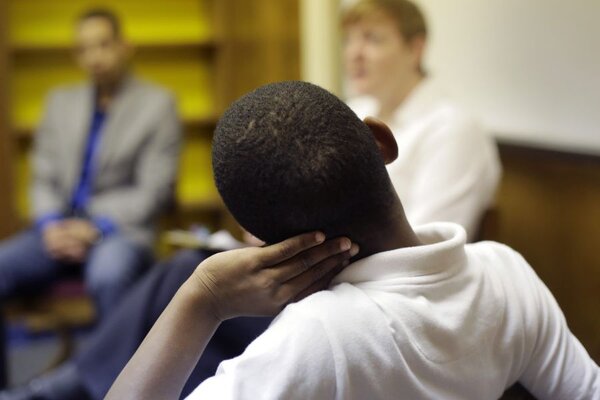L.A. schools swapped 'zero tolerance' for 'restorative justice.' Is it working?
Staff applaud the goals of 'restorative justice,' a community-minded alternative to schools' 'zero tolerance' policies, which have not proven to be effective, but they add that more training and resources are needed.

San Antonio seventh grader Jayden Witter discusses a recent conflict at school in a restorative justice circle at Ed White Middle School. Districts across the country have experimented with restorative justice methods, which emphasize relationships and problem-solving, as an alternative to zero tolerance policies. Eric Gay/ AP
When a South Carolina sheriff's deputy threw a high school student from her chair in late October, tossing her across the classroom in a cellphone-captured video that quickly went viral, Americans caught a glimpse of how debates over school discipline play out every day in the nation's schools, where "zero tolerance" policies have led to an uptick in police referrals and out-of-school suspensions.
What makes students misbehave? What is the appropriate punishment? For years, educators have grappled with how to keep students and staff safe from fights and extreme disruptions, often combating disrespectfulness with policies often solve the immediate problems, but often also lead to to long-term academic failure.
California has led the way in an alternative practice, called "restorative justice," that holds promise in building students' understanding, responsibility, and relationships, while keeping students at their desks. But in Los Angeles, the nation's second-largest district, teachers are now alleging that administrators have put the policy in place with little training, creating chaos for students and staff alike.
On the face of it, banning suspensions for "defiance" has been a numerical success: as the Los Angeles Times reports, suspensions are down to 0.55 percent, compared to 8 percent in the 2007-2008 school year.
On the ground, though, some teachers allege that it's been a change for the worse: they claim that disciplinary issues are getting out-of-hand, and leaving teachers at a "breaking point," in the words of school union rep Art Lopez.
"Where is the justice for students who want to learn?" math teacher Michael Lam asked at a district forum, citing pressure to keep disruptive student in class.
Superintendent Ramon Cortines agrees that implementation had not been well thought-out. "You cannot piecemeal this kind of thing," he told the Times.
Psychologists and educational researchers support restorative justice as a means to build community, bolster students' problem-solving and accountability, and resolve conflicts, often through intense discussions that emphasize mutual respect between students, staff, and parents as they reflect on what caused problems in the first place and how L.A. schools swapped 'zero tolerance' for 'restorative justice.' Is it working? - CSMonitor.com:
